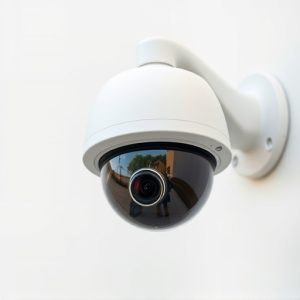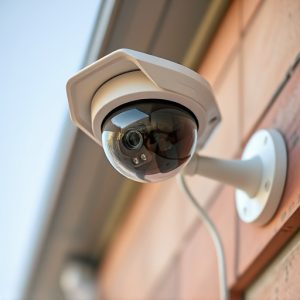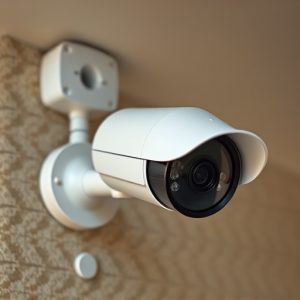Powering Your Dummy Security Cameras: Wired vs Wireless Options
Placing dummy security cameras requires strategic consideration of location, height (adhering to Dum…….
Placing dummy security cameras requires strategic consideration of location, height (adhering to Dummy Security Camera Height Guidelines), lighting, and power sources (wired vs wireless). Mounting them at optimal heights – 1.8-2.4 meters for clear views, or 5-7 feet indoors/outdoors based on guidelines – ensures effective surveillance without privacy intrusion. Integrating these cameras with smart home systems enhances security through automated routines triggered by events, further deterring intruders.
In today’s world of home security, dummy security cameras offer a discreet yet effective solution. This comprehensive guide explores all aspects of selecting and optimizing your dummy camera setup. From understanding crucial placement factors like Dummy Security Camera Height Guidelines to choosing between wired and wireless power sources, this article ensures you make informed decisions. Learn about battery life considerations, integration with home automation systems, and more, to enhance your security network efficiently.
- Understanding Dummy Security Camera Placement: Factors to Consider
- Power Sources for Dummy Cameras: Wired vs Wireless Options
- Height Guidelines: Optimizing Visibility and Coverage
- Battery Life and Maintenance for Unplugged Cameras
- Integrating Dummy Cameras with Existing Home Automation Systems
Understanding Dummy Security Camera Placement: Factors to Consider
When placing a dummy security camera, understanding the factors that influence its optimal position is key to effective surveillance. Location plays a significant role; avoid areas with excessive obstructions like trees or signage which could block the camera’s field of view. Dummy cameras are most effective when positioned at a height that offers a clear, unobstructed line of sight, typically between 10-20 feet (3-6 meters) off the ground, aligning with the Dummy Security Camera Height Guidelines.
This strategic placement ensures comprehensive coverage while adhering to privacy standards, as it captures activity without intruding on individuals’ personal spaces. Additionally, consider lighting conditions; well-lit areas during both day and night enhance the camera’s performance, providing clearer images for better identification.
Power Sources for Dummy Cameras: Wired vs Wireless Options
When considering power sources for dummy security cameras, there are two primary options: wired and wireless. Wired cameras connect directly to a power outlet, offering reliable and consistent power supply. This option is ideal for those seeking a more permanent installation, as it eliminates the need for frequent battery replacements or charging. Additionally, wired cameras often provide higher resolution and better performance compared to their wireless counterparts.
Wireless dummy security cameras, on the other hand, operate using rechargeable batteries, allowing for flexible placement anywhere within range of the signal. This is particularly advantageous for those looking to adhere to specific Dummy Security Camera Height Guidelines or install cameras in hard-to-reach areas without direct access to power outlets. While battery life varies among models, recent advancements have seen improvements in wireless camera technology, closing the gap with wired options in terms of performance and reliability.
Height Guidelines: Optimizing Visibility and Coverage
When placing dummy security cameras, understanding optimal height guidelines is essential for maximizing both visibility and coverage. Generally, mounting them at eye level or slightly above ensures a clear line of sight, allowing the camera to capture high-quality footage without obstructions. For indoor spaces, this usually translates to heights ranging from 6 to 8 feet (1.8 to 2.4 meters), while outdoor installations might require adjustments based on environmental factors like trees or structures nearby.
By adhering to these dummy security camera height guidelines, you can ensure that the cameras provide comprehensive surveillance, offering a clear view of entry points, corridors, and critical areas. This strategic placement enhances overall security, providing peace of mind and effective deterrence against potential intruders.
Battery Life and Maintenance for Unplugged Cameras
When it comes to unplugged dummy security cameras, battery life is a key consideration. These cameras, designed to mimic real surveillance equipment but without the need for an external power source, rely on batteries that can withstand periods of inactivity and prolonged use. High-quality lithium ion batteries are often recommended for their long lifespan and reliable performance. Regular maintenance involves checking battery levels and replacing them as needed, following manufacturer guidelines for optimal camera function.
In terms of Dummy Security Camera Height Guidelines, positioning is equally important. While unplugged cameras don’t require cords or plugs, their strategic placement ensures maximum coverage and visibility. Typically, mounting the camera at a height of 5-7 feet (1.5-2.1 meters) above ground level offers a balanced view, capturing clear images without being too obtrusive. This standard height is suitable for various indoor and outdoor settings, providing a discreet yet effective security solution.
Integrating Dummy Cameras with Existing Home Automation Systems
Integrating dummy security cameras with your existing home automation system can enhance overall security and provide a seamless smart home experience. Many modern dummy cameras are designed to be compatible with popular automation platforms, allowing them to communicate and be controlled alongside other devices like smart lights, thermostats, and locks. This integration offers several advantages. For instance, you can set up automated routines where the camera turns on when specific events occur, such as motion detection or when a door is opened, syncing perfectly with your home’s overall security measures.
When considering the placement of these cameras, it’s essential to adhere to recommended Dummy Security Camera Height Guidelines. Typically, this means positioning them at eye level (around 6-7 feet) to ensure optimal visibility and deter potential intruders. By combining the strategic placement of dummy cameras with a well-connected home automation system, you can create an efficient, responsive security network tailored to your residence’s unique needs.
When it comes to selecting the ideal dummy security camera, understanding your power options is key. Whether you opt for a wired or wireless setup, each has its pros and cons. By adhering to the provided height guidelines, ensuring optimal visibility and coverage, and managing battery life for unplugged cameras, you can maximize the effectiveness of your security system. Additionally, integrating these dummy cameras with your home automation network allows for enhanced control and monitoring, contributing to a safer and more connected living environment.


